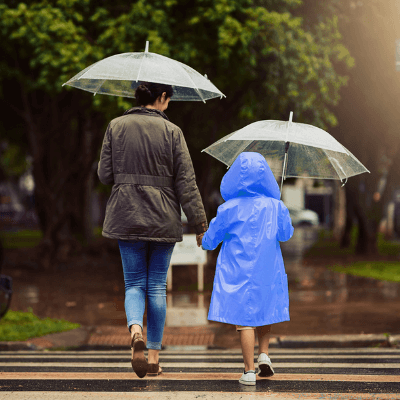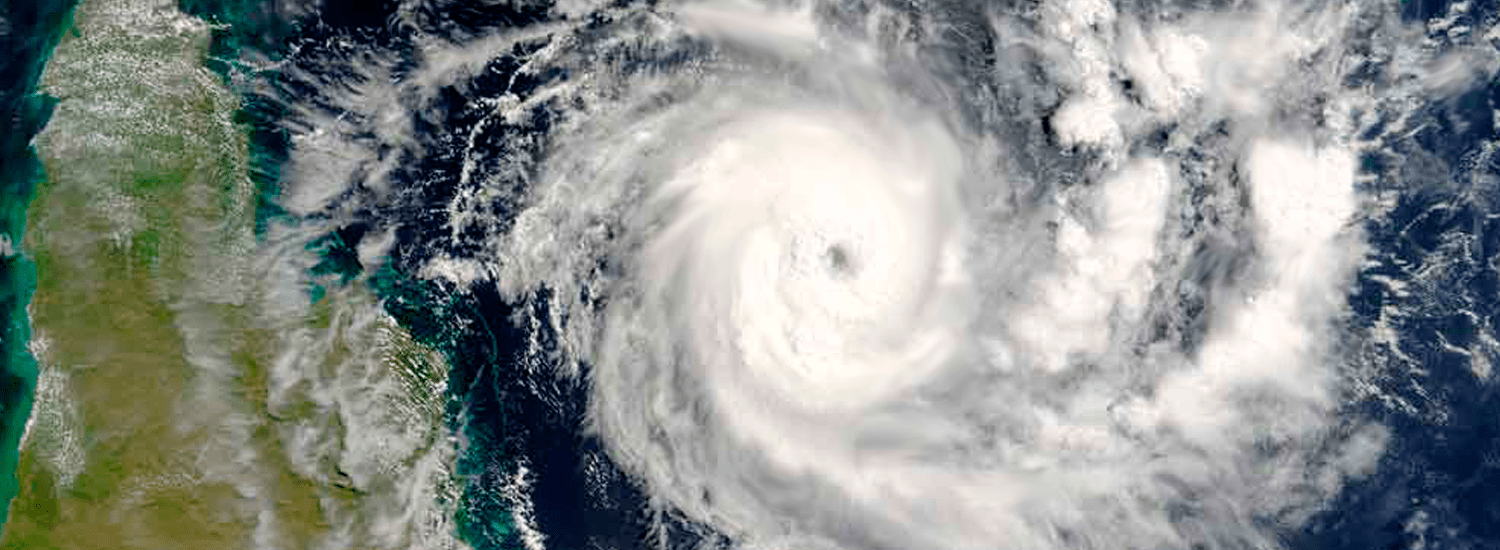Ready or not? How Australians can better prepare for extreme weather
Australia is known for its extreme conditions and wild weather. From bushfires and severe storms to flash floods and earthquakes, we’re no stranger to mother nature’s unpredictability.
But many Aussies could be more prepared for extreme weather and natural disasters, according to QBE research*. Just a quarter (25.6%*) of Australians describe themselves and their homes as prepared or very prepared for natural disaster and weather events. The rest say they’re either unprepared (22%*), or only somewhat prepared (52%*). While a significant 71 per cent don’t have an emergency preparedness plan*, according to the research delving into the behaviours and attitudes of more than 1,000 Australians.
There’s opportunity for Aussies to better prepare and protect themselves and their homes, says Arron Mann, General Manager Claims, QBE Australia Pacific.
"Thousands of homes and communities are damaged or destroyed by natural disasters and extreme weather each year, but in many cases, this can be avoided or minimised with the right preparation measures."
Here’s what else the research revealed and the opportunities it highlights, according to Mann.
Storms top the list of concerns as we head into summer
When it comes to disaster and weather events, storms are our biggest worry, with a notable 28 per cent* of respondents naming storms as the event they’re most concerned about.
 It’s understandable storms concern us, says Mann.
It’s understandable storms concern us, says Mann.
"Australia has already seen extreme storm and hail activity over spring, and we can expect more to come in summer.
"Thunderstorms are predicted to be more frequent in northern New South Wales, southern Queensland, inland Western Australia and across the tropical north."
But storms aren’t the only weather event to prepare for, says Mann.
Australia’s Bureau of Meteorology (BOM) has declared a La Niña event has been established in the Pacific Ocean."We’re likely in for a wet summer which also brings the risk of flooding and flash flooding."
And according to the BOM, Australia has a 65 per cent chance of more tropical cyclones than usual between now and April 2022.
"Tropical cyclone activity stems from tropical lows - even if they don’t turn into cyclones, they can still cause storms, damaging winds, increased rainfall and flooding," says Mann.
Recent rain has also meant significant grass, crop and shrub growth in many regions, so with temperatures rising bushfire also remain a risk for parts of the country, says Mann.
1 in 4 Aussies impacted but many don’t think it could happen to them
Many Australians have suffered the wrath of extreme weather and disaster events.
"QBE responds to tens of thousands of claims for these events every year," says Mann.
In fact, 13.6 per cent of total QBE property claims for the year were catastrophe claims related to weather events and natural disaster events considered catastrophic by QBE and or the Insurance Council of Australia**.
"These Catastrophe claims account for 37.1 per cent of total cost incurred across all QBE property claims, revealing on average CAT claims incur more than double the cost of other claims.
"This is reflective of the level of damage these claims cause – often requiring extensive repairs and provision of temporary accommodation."
And the research paints a similar picture. One in four Australians (26.1%*) have had their home or property damaged by extreme weather or natural disaster events, according to the research. Hail (36.7%*) and storms (30.3%*) followed by bushfire (27.3%*) were the top drivers behind damage.
These events can cause thousands of dollars’ worth of damage, see homes lost entirely and cost much more than money, says Mann.
"Insurance can offer important financial protection, but even if you have cover, the emotional and psychological cost of an incident can be significant," says Mann.
Despite this impact, the research indicates many Australians don’t think a natural disaster or extreme weather event could affect them. Of those who don’t have an emergency preparedness plan, 37 per cent say it’s because they don’t think they need one.
A real red flag says, Mann.
"Some disasters can seem like an abstract risk if you’ve never experienced one, but they happen, and usually without warning."
Although the level of risk is higher for some regions, weather and disaster events like storms and floods can affect any part of Australia at any time, says Mann.
"And it’s the events that surprise us most that often do the worst damage," says Mann.
"A good example of this was Cyclone Seroja in April 2021 - it hit further south than was expected for an event of its kind, taking thousands by surprise, and destroying homes that were not designed or expecting to withstand cyclone damage."
Most Aussies are insured but their cover may not be right
Most Aussies have insurance, but many aren’t sure if their cover is right, according to the research.
Of those that own homes and have home insurance (96.1%*), just 41.6 per cent* are confident the amount their home is insured for is enough. And less than half (43.1% *) of those who have contents insurance are confident the amount they were insured for would be enough to cover the replacement value of their belongings.
| What would you take with you if disaster struck? |
|
If a natural disaster or extreme weather event strikes, people will often need to leave their homes at a moment’s notice. Overwhelmingly, almost four in 10 (38%*) Australians say they’d take their mobile phone with them over any other item in this frightening scenario. Photographs (including photo albums) and laptops were the next most popular items. Significantly, for most the driving factor behind this choice is practical or sentimental value – not financial. “Naturally, people’s safety and treasured sentimental items are the items that matter most to them in a scenario like this. "Insurance can help protect people’s financial wellbeing, but it can’t replace those items unfortunately. That’s why preparation is so important," said Mann. |
"Insurance can offer important financial protection if something goes wrong, but it’s important to make sure your level of cover and sum insured is right – your home needs to be insured for how much it would cost to start from scratch and rebuild it to current building codes," says Mann.
"The same goes for contents insurance – the amount you’ve insured your belongings for needs to be enough to replace everything brand new."
Understanding what your policy does and doesn’t cover is also essential, adds Mann.
"While events like storms are covered in most home policies you might find that you aren't covered for some catastrophe scenarios like flood or bushfire. QBE’s policies provide cover for these events but not all policies do."
Reading policy documents is key to this, but many Australians aren’t paying close attention to these important documents, according to the findings, says Mann.
Of those who had insurance^ (83.9%*) an alarming 42 per cent* say they have either never read their PDS and policy documents or were unsure when they last read them.
"If you don’t have insurance, it’s worth considering the protection it can offer. Think about the types of policies and cover you may need including temporary accommodation you could need if you lost your home or rental."
If you need help understanding your policy or cover, talk to your insurer or broker, says Mann.
Estimate the value of your home and contents with these calculators
7 in 10 Aussies don’t have this important defence in place
While some Aussies have taken at least some measures to prepare, most can better protect their homes and belongings, says Mann.
QBE’s research revealed a promising 70 per cent of Aussies* have one or more home disaster preparation and protection measure or practice in place, however concerningly the vast majority don’t have a regular home maintenance schedule to support disaster protection (70%*).
Home maintenance is essential to keeping our properties protected, says Mann.
"Regular home maintenance is an essential part of disaster preparedness and in many cases is the most powerful protection measure.
"Things like clearing debris from gutters, having the roof checked for damage, having cracks and gaps sealed, and ensuring tree branches are trimmed back are simple measurers - but can make all the difference.
"It’s also important to understand the specific types of events that could affect your home or vehicle and then it’s about making plans and taking action accordingly. Local councils and emergency authorities can help you identify risks in your area, outline any local plans and give recommendations for each."
The good news is preparing for one risk can often protect you from others, says Mann.
Aussies know their neighbours, and this could help better protect them
When disaster strikes, knowing your neighbours and having connections with your community can make a big difference, and according to the research many of us do.
Four in five Australians (81.1%) know our neighbours, and 45 per cent say they know them better than they did 12 months ago.
These Aussies are in a better position to deal with a disaster situation, says Mann.
But just 9.4 per cent* of respondents have discussed disaster preparedness with a neighbour.
"If something hits and you’re not home, knowing your neighbour can be extremely helpful even if it’s just to bring the dog inside or tie down some outdoor furniture."
But they may in fact help in far more significant ways.
"In many emergency situations the person most likely to come to your aid will often be a neighbour or local. By building a support network of people in your community you can help each other prepare before and get by during, and after, an emergency."
"That’s why having conversations with neighbours and people around us is so important.
"Talk to them about what to do in emergency events, any lived experiences and preparedness measures you both may have, and how you can help each other in times of need."
Most of us haven’t talked to the ones we love about wild weather and disasters
Not only do most Aussies (71%) say they don’t have a plan for an extreme weather event or a natural disaster hitting their home, but they haven’t even talked about it with the ones they love.
A significant 64 per cent* of Australians haven’t discussed natural disaster planning or preparedness with anyone, including immediate family members in the last 18 months.
"When disaster strikes, knowing what to do save precious time, property and most importantly lives."
Under 30 per cent (28.2%) of research respondents have discussed disaster preparedness with immediate household members.
Despite this, many Australians expect family support to be key for helping to deal with natural disasters or extreme weather if one were to impact them, with 55 per cent of research respondents saying they would rely on family for general support.
These conversations are also essential to keeping more vulnerable family members safe.
Only 4.6 per cent* of respondents have spoken with vulnerable or special needs non-household family members, who are likely to need help most, says Mann.
"Planning and discussions will help ensure that all the members of your household and family including children and people with disabilities or vulnerabilities know what to do, how to reach each other or meet, and what to do in a disaster or emergency.
"Every family should have an emergency plan and kit."
How Australians can better prepare
The best way to protect yourself from a natural disaster is to have a plan and take steps to lower the risks, says Mann.
- Think about the types of events that could affect you, the likelihood of these occurring and plan and act accordingly.
- Consider insurance and review your cover to make sure it’s correct. Ensure your home is insured to cover rebuild costs, considering increasing construction costs and building standards.
- Have conversations with family, friends and neighbours, and discuss how to prepare and help each other. If you intend to stay with someone, develop contingency plans in case they are also affected and unable to assist.
- Put a home maintenance schedule in place and get a home health check from qualified tradespeople and specialists. Ensuring home repairs are up to date could protect your home and potentially assist with insurance claims.
- Make an emergency plan and prepare a survival kit. Ensure important documents and valuables are easily and quickly accessible in case you need to evacuate your home.
You can also prepare using some of our resources, created to help homeowners reduce the risks they face including checklists for cyclones, storms and bushfires.
Find out more about QBE Home Insurance
Find out more about QBE car insurance
class="qbe-terms">*Polling study of 1,009 Australians, aged 18-65, completed for QBE Insurance Australia in October 2021
**QBE Home and Contents property claims for 2021 (Jan 2021 – Nov 2021) including Elders insurance
^ personal insurance including comprehensive car or home and/or contents insurance
1nhttp://www.bom.gov.au/climate/outlooks/#/overview/summary










